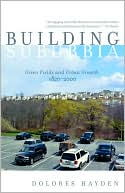

 |

|

The average rating for Building Suburbia: Green Fields and Urban Growth, 1820-2000 based on 2 reviews is 2.5 stars.
Review # 1 was written on 2017-03-20 00:00:00 Angela Leaf Angela LeafReally interesting study of how our current suburban landscapes came to be. Main takeaway: real estate developers are crooks and con artists (no surprise there). I agree with her conclusions about how to foster sustainable development in the future, and I think she'd be glad to see that they have been increasingly implemented over the decade or so since the book came out. |
Review # 2 was written on 2018-09-01 00:00:00 Wayne McGraw Wayne McGrawThis book was intensely frustrating to read. Indeed, this volume, which has about 250 pages of the author bloviating on topics related to the long history of suburban development in the United States, is all the evidence one would need to demonstrate how a misguided political worldview hinders one from obvious insights and basic knowledge about what the writer is writing about. The author seems to think that "conservative" is a pejorative expression, and it is one she uses often in an ad hominem fashion, as if to be right-of-center politically is to mean that one's behavior is automatically bad for the ordinary people that the author claims to support. After reading this book, I was convinced that the world would likely be a better place if the author were flattened and macadamized to make a road to some greenfield suburb so that she could stop writing terrible books like this one. And as is so often the case in books that deal with property and development [1], the worldview error of the author is the central problem from which the book's failure flows. Given the author's strident tone and call for activism among readers, it is unlikely that this error is soon to be improved. This volume's contents are divided into three parts and eleven chapters. The author begins with a preface and acknowledgements and then proceeds to write about the American metropolitan landscape (I) with a discussion about the shapes of suburbia (1) and the suburban city (2). After that several chapters examine in a more or less chronological fashion some historic patterns of suburbs in the landscape (II), moving from borderlands (3) to picturesque enclaves (4), to streetcar buildouts (5), to mail-order and self-built suburbs (6) to sitcom suburbs (7), to edge nodes (8) and finally to rural fringes (9). After this comes a couple of chapters where the author pontificates on the future of suburbs (III) with a look at nostalgia and futurism (10) and attempts to encourage the smart development of older suburbs (11) in order to increase density and provide housing for all kinds of illegal immigrants. Throughout the volume the author makes note of various thinkers who are like her, as if that is a good thing. Over and over again, the author makes snarky comments about conservative people, and posits a false dilemma between the desire of Americans to escape living in the city and avoid the high-density sort of housing that the author endorses and the businesses that provide for that through property speculation and development. Far from being the villains of the American story, as the author appears to believe, property speculators have always been among the heroes of the efforts to provide a wide base of Americans with property to develop for their own economic and political independence, efforts which the author denigrates at every possible opportunity. The author appears to think that the United States should be like Europe, the sign of moral and political bankruptcy as far as someone's worldview is concerned. Unable to appreciate and enjoy the United States and its development as it is, and comment that the gigantism in terms of politics and business is a serious problem that leads to a great deal of the sprawl that we find, the author consistently urges a desire for high-density construction (even having nice words to say about massive socialistic housing projects) and intrusive neighbors, and disregards the consistent American preference for low-density construction that provides a sense of distance between personal life and the problems of the city that we wish so strenuously to avoid. The author's political worldview makes her tone deaf to the fact that people genuinely like living in suburb and exurbs and do not want to live in the city unless they are corrupt Eurotrash hipsters like she is. [1] See, for example: |
CAN'T FIND WHAT YOU'RE LOOKING FOR? CLICK HERE!!!